Hello Eric.Interesting Steve, but it's not obvious to me how this panel is actually driven. Does he explain it anywhere? Or do you think you understand what he's actually doing?
Eric
I was more interested in the drive mechanism , using the flat card forma, which I thought could replace the circular coil.
As for his setup in the video.
It looks to me, that he is using two panels held together with masking tape, the driver is attached to the panel by splayed paper or card, each attached to the separate panels
This uses the central slot as a tweeter .
I would describe this panel as a flat rubanoide as they use the same drive mechanism .
I hope this helps your understanding of his panel.
Steve.
Looks like they're dead - company split up into parts and goneThe JMC soundboard looks plenty curved & apparently goes nearly full-spectrum 35-20KHz, using 8 "vibrators" for their almost 1m square panel. (Can't recall if anyone on this thread has heard these or not). Panel is curved outward/convexly towards the listener.
They may be gone as well - no real info on them at allConversely, the Teragaki Lab panels are curved inwards/concave.
DML- the land of the dead and buried ---it's up to us to keep the lamp lit 🪔
He did mount this on a larger panel, but I can't find that video for some reason .
I'm sure it must still be there somewhere.
Steve.
I'm sure it must still be there somewhere.
Steve.
Last summer I prototyped a rectangular 3mm perspex sheet tensioned into a curve with nylon wire melted onto the perspex. I think curved it to around 120 degrees off horizontal. The idea was to make it easier to mount on the wall, directivity, aesthetics and the general stiffness. Struggled to engineer a flat mounting surface for the driver. Engineer is a strong word for what I do, but I'm sure you know what I mean. All guesswork on a hunch.Hello Eucy
The coincidence frequency seems to play the first role, at least to avoid strong lobes out of the axis. It is possible following the theory to increase the coincidence frequency by increasing the areal density (heavier material so lower efficiency) and by decreasing the bending stiffness.
Curving the panel will focus the different areas to the axis. It might be a solution to avoid the loss of HF on axis. I imagine it will also increase the stiffness in the plan perpendicular to the curve so maybe some thickness reduction needed...
Christian
I'll keep an eye out for any (more informed) suggestions.
Just a note on these designs - I haven't heard the Japanese one and only a sales recording of the Swiss one (Looks like they're dead - company split up into parts and gone
They may be gone as well - no real info on them at all
DML- the land of the dead and buried ---it's up to us to keep the lamp lit 🪔
The Swiss one has more of a light touch and high quality workmanship, but still I'm doubtful about the performance in the lower frequencies. It seem to me to be more 'show' than 'go'. Bass tones were described as 'discreet' with improvement over time (3 yrs mentioned).
However, I'll never get the chance to find out.
Eucy
Last edited:
This company is also making dml speakers mixed with musical instrument making techniques.
https://www.la-voix-du-luthier.com/
Their cheapest model uses a free floating soundboard (minimal damped round dml panel).
Nice units, and they aim at a sensible compromise - not a flat sound, but nice and interesting. Mainly aimed at muscicians.
https://www.la-voix-du-luthier.com/
Their cheapest model uses a free floating soundboard (minimal damped round dml panel).
Nice units, and they aim at a sensible compromise - not a flat sound, but nice and interesting. Mainly aimed at muscicians.
I experimented a little with stressing XPS into a curved form but nothing I tried seemed like an improvement. One thing I noticed is that flexing a panel is a lot like tightening a string on an instrument, which leads to the panel resonating more at certain frequencies.
Yep - It appears they've been very successful in that niche market where they're not being compared to a traditional speaker. I think they'd sound somewhat weird on vocals etcNice units, and they aim at a sensible compromise - not a flat sound, but nice and interesting. Mainly aimed at muscicians.
Eucy.
I think that their panels are used as a musical instrument extention.
You can alter and adjust the sound to your preferences.
Ultimate fidelity is not issue, but flexibility in producing the sound and the effects you desire.
They also have very good wide audience coverage , as shown in some of their videos.
Steve.
I think that their panels are used as a musical instrument extention.
You can alter and adjust the sound to your preferences.
Ultimate fidelity is not issue, but flexibility in producing the sound and the effects you desire.
They also have very good wide audience coverage , as shown in some of their videos.
Steve.
Curved panels were discussed recently. Here is a curved panel speaker. DML is not mentioned anywhere, but I am convinced it is DML technology that produces the main marketing claim here - intelligibility.
https://soundfun.net/
https://soundfun.net/
Hi twocents, thanks for the interesting link to the mirai! It looks like this is not really a dml, but a kind of walsh type speaker. The driver (small cone speaker) is in line with the panel. In their demonstration videos of the curved panel they use it as a dml though, demonstrating how stiffening of the panel by bending it makes the panel more efficient.
Hvdz.
Yes it seems like a bending wave speaker similar to the Walsh.
But more closely related to the linaeum or rubanoide.
But only using half of the drive surface.
It would be very easy for them to drive the two surfaces similar to the last two types, I wonder why they only use the one surface?
Steve.
Yes it seems like a bending wave speaker similar to the Walsh.
But more closely related to the linaeum or rubanoide.
But only using half of the drive surface.
It would be very easy for them to drive the two surfaces similar to the last two types, I wonder why they only use the one surface?
Steve.
Also the material is too floppy for a good dml use, so they have to stiffen the material by bending it.
Steve.
Steve.
SteveAlso the material is too floppy for a good dml use, so they have to stiffen the material by bending it.
Steve.
Are you assuming that the panel they play with the music box is the actual panel material? I was thinking it’s just what they chose for the demonstration. But I certainly don’t have any way of knowing.
Eric
Back to flat panels ----
Having moved house and state, I've only recently been able to re-establish testing in any meaningful way. I've now put in place an EMM-6 mic coupled with a Behringer UMC22 interface with loopback timing. All good - excellent in fact.
So I was dismayed when I saw the results of the Blackwood panels and I couldn't perceptually align the results with previous tests on the same material. I have been mostly using a Fosi Audio BT30D Class D bluetooth amp, but recently also hooked up my old Sony Class A amp. Even with my poor hearing, I was struck by the difference in warmth between the Class A and D, with the A seeming much more warm and lively.
Anyway, the alarming tests were carried out using the Class D, and these are shown traces 6 and 7 in the attached graph.
I then switched to the Class A and that is shown in trace 4 - a significant difference in slopes on both bass and treble, but still a lot of roll-off in HF. The large hump at approx 550-600Hz is also notable (yet to be tracked down). I have another Fosi amp so I'll get around to do a comparison test but the results indicate an issue with this one at least.
I began to ruminate as to the likely cause of HF roll off in this and basically all panels shown and discussed in this thread. My belief is now that it's really related to the shifting of HF response towards the exciter as frequencies rise, to the point where there is simply not enough energy across the panel to maintain sufficient SPL. This can be addressed by using multiple panels or EQ, but is there another way?
Now we generally understand that multiple exciters will interfere with one another at certain frequencies, and so the preference is to use a single exciter. In this case I'm using the DAEX30HESF-4 (40W-30mm VC). There is also a generally accepted viewpoint that smaller VC diameters are better at HF than larger ones, and others (Andre?) have commented on VC collapse of the DAEX30HESF at high frequencies, a possibility which may be exacerbated by relatively high stiffness of the Blackwood, despite it being only 2mm thick. So maybe the exciter comes into play as well, but I do believe that the roll-off is mainly caused by the migration of impulses towards the exciter at HF.
To test this out, I decided to try a second smaller exciter (DAEX25FHE-4- 24W-25mm VC), but positioned in a way which hopefully mitigates interference.
I connected the second exciter using A-B speaker outputs on the Class A amp, sent a 3kHz test tone to the panel and moved the exciter around to maximise the output. I concentrated on the upper section of the panel for practical purposes, and the best location ended up to be near the top corner of the panel on the same side as the offset main exciter. So it ended up being about 300mm or so above and 70mm to the side of the main exciter.
Initial listening tests didn't show any detrimental effects (maybe my hearing LOL).
I then did 2 measurement sweeps and these are shown in traces 1 and 2. Immediately noticeable is the 10dB gain @ 10k, but also surprisingly measurable gains across the bass and mid frequencies. The second exciter has in essence flattened the curve significantly (again ignoring the 600hZ hump)
In addition, and again surprisingly, THD was reduced, and Step and Impulse responses both improved over the single exciter case.
I'm certainly not an expert in the use of REW but these results indicate that a significant improvement has been achieved here.
Comments welcomed
Eucy
Having moved house and state, I've only recently been able to re-establish testing in any meaningful way. I've now put in place an EMM-6 mic coupled with a Behringer UMC22 interface with loopback timing. All good - excellent in fact.
So I was dismayed when I saw the results of the Blackwood panels and I couldn't perceptually align the results with previous tests on the same material. I have been mostly using a Fosi Audio BT30D Class D bluetooth amp, but recently also hooked up my old Sony Class A amp. Even with my poor hearing, I was struck by the difference in warmth between the Class A and D, with the A seeming much more warm and lively.
Anyway, the alarming tests were carried out using the Class D, and these are shown traces 6 and 7 in the attached graph.
I then switched to the Class A and that is shown in trace 4 - a significant difference in slopes on both bass and treble, but still a lot of roll-off in HF. The large hump at approx 550-600Hz is also notable (yet to be tracked down). I have another Fosi amp so I'll get around to do a comparison test but the results indicate an issue with this one at least.
I began to ruminate as to the likely cause of HF roll off in this and basically all panels shown and discussed in this thread. My belief is now that it's really related to the shifting of HF response towards the exciter as frequencies rise, to the point where there is simply not enough energy across the panel to maintain sufficient SPL. This can be addressed by using multiple panels or EQ, but is there another way?
Now we generally understand that multiple exciters will interfere with one another at certain frequencies, and so the preference is to use a single exciter. In this case I'm using the DAEX30HESF-4 (40W-30mm VC). There is also a generally accepted viewpoint that smaller VC diameters are better at HF than larger ones, and others (Andre?) have commented on VC collapse of the DAEX30HESF at high frequencies, a possibility which may be exacerbated by relatively high stiffness of the Blackwood, despite it being only 2mm thick. So maybe the exciter comes into play as well, but I do believe that the roll-off is mainly caused by the migration of impulses towards the exciter at HF.
To test this out, I decided to try a second smaller exciter (DAEX25FHE-4- 24W-25mm VC), but positioned in a way which hopefully mitigates interference.
I connected the second exciter using A-B speaker outputs on the Class A amp, sent a 3kHz test tone to the panel and moved the exciter around to maximise the output. I concentrated on the upper section of the panel for practical purposes, and the best location ended up to be near the top corner of the panel on the same side as the offset main exciter. So it ended up being about 300mm or so above and 70mm to the side of the main exciter.
Initial listening tests didn't show any detrimental effects (maybe my hearing LOL).
I then did 2 measurement sweeps and these are shown in traces 1 and 2. Immediately noticeable is the 10dB gain @ 10k, but also surprisingly measurable gains across the bass and mid frequencies. The second exciter has in essence flattened the curve significantly (again ignoring the 600hZ hump)
In addition, and again surprisingly, THD was reduced, and Step and Impulse responses both improved over the single exciter case.
I'm certainly not an expert in the use of REW but these results indicate that a significant improvement has been achieved here.
Comments welcomed
Eucy
Attachments
-
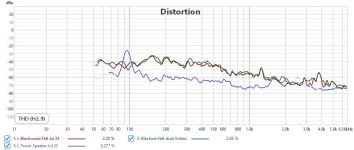 240724 - Distortion.jpg87.4 KB · Views: 77
240724 - Distortion.jpg87.4 KB · Views: 77 -
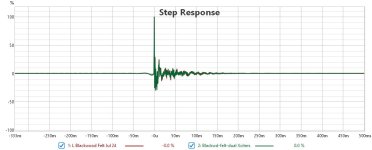 240724 - Bwood Dual Step.jpg62.6 KB · Views: 66
240724 - Bwood Dual Step.jpg62.6 KB · Views: 66 -
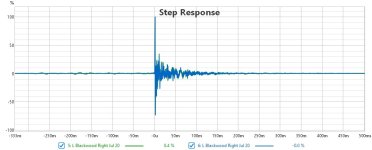 240724 Bwood Single -Step.jpg65.3 KB · Views: 57
240724 Bwood Single -Step.jpg65.3 KB · Views: 57 -
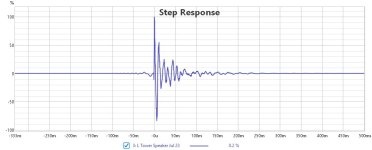 240724-Tower Step.jpg60.7 KB · Views: 57
240724-Tower Step.jpg60.7 KB · Views: 57 -
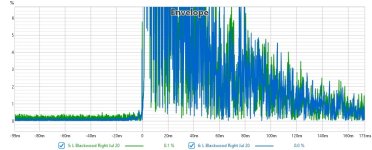 240724 Bwood Single - ETC.jpg106.6 KB · Views: 60
240724 Bwood Single - ETC.jpg106.6 KB · Views: 60 -
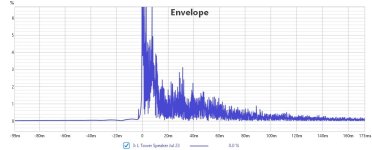 240724-Tower ETC.jpg76.6 KB · Views: 61
240724-Tower ETC.jpg76.6 KB · Views: 61 -
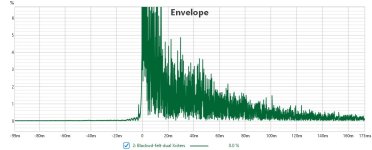 240724 Bwood Dual - ETC.jpg80.2 KB · Views: 61
240724 Bwood Dual - ETC.jpg80.2 KB · Views: 61 -
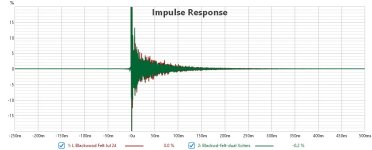 240724 Bwood Dual Exciter Impulse.jpg77.6 KB · Views: 59
240724 Bwood Dual Exciter Impulse.jpg77.6 KB · Views: 59 -
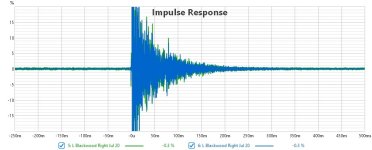 240724 Bwood Single Exciter Impulse.jpg84.7 KB · Views: 60
240724 Bwood Single Exciter Impulse.jpg84.7 KB · Views: 60 -
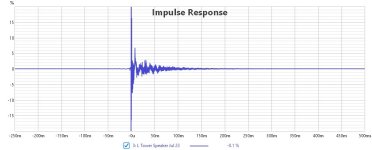 240724 Tower Impulse.jpg73.1 KB · Views: 74
240724 Tower Impulse.jpg73.1 KB · Views: 74 -
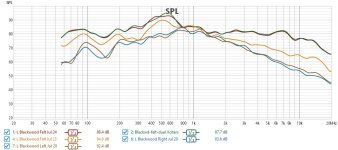 240724 Blackwood panels.jpg110.2 KB · Views: 79
240724 Blackwood panels.jpg110.2 KB · Views: 79
Which ever drive method they use it will be mainly bending wave.Steve
Are you assuming that the panel they play with the music box is the actual panel material? I was thinking it’s just what they chose for the demonstration. But I certainly don’t have any way of knowing.
Eric
Or are you thinking it could be an internally driven bending foil ?
I found that my small card panels worked very well for TV intelligibility when used with my surround sound system.
I would have left them in place, but my dog would have destroyed them in no time 🫣
I would have to make them bomb (dog) proof .
This mirai speaker seems to me, like a very complicated way to achieve this ?
Steve.
- Home
- Loudspeakers
- Full Range
- A Study of DMLs as a Full Range Speaker